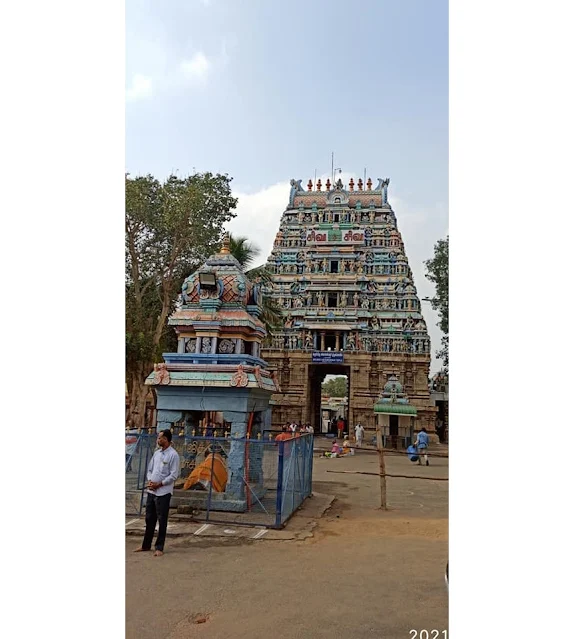SANGAMESHWARAR TEMPLE - BHAVANI- TAMILNADU.
Rishi Parashara, had received a small quantity of nectar or Amrit, which he wanted to preserve for the welfare of the world. He hid the Ambrosia under the ground and started his Penance.
Four Asura's wanted to usurp the nectar. Sage Parashara invoked Mahadev to protect the nectar, which Lord Shiva did by chasing the Asura's away.
Thanking Lord Shiva, the sage tried to retrieve the pot of Nectar from the ground and to his amazement he found a Lingam in it. When he lifted the Lingam, a jet spring of water burst out from beneath the Lingam.
The water coming out of the pot of Ambrosia (known as Amudha) and from beneath the Lingam, flowed and mixed with the waters of the river Cauvery and Bhavani flowing nearby. Hence the place is known as Mukkadal, Kooduthurai or Sangam. The place is also known as Dakshina Prayag & the Lingam Installed by Rishi Parashara is known as SANGAMESHWARAR.
HISTORY
Mahendra Verman l, the Pallava King(571-630 CE), built this temple. The temple since then has passed through the hands of many kingdom including the Chola,Pandya, Vijayanagara, Nayaka. The temple is referred to in the "Thevaram" a canonical work of Shaivite Saints,(where Tirugnanasambandar has sung in praise of Lord Sangameshwarar) dating back to the 7th century CE.
In 1802 a British officer, named William Garo donated a cradle made of Ivory to the Goddess Vedanayaki, for saving him from his house collapse.
Mumudi Getti Mudaliar's who ruled from Amarakunthi near Salem and who are credited with the reconstruction of the Kailasanathar temple at Taramangalam were the vassals of the Nayaks of Madurai.Their sister Chinnammal is credited with the construction of the Nritya Mandapam as per the inscription in the temple.
TEMPLE
The Temple in itself is thought to be a Shiva Linga, and hence the northern entrance of a 5 tiered Rajagopuram is the Nandi Mandapam with a Nandi outside the temple. Before entering, are the shrines of Ganesha and Hanuman. On entering the all shrines are to the right facing east in a four acre compound with the Cauvery and Bhavani flowing to the left.
The 1st shrines are that of Rajaganapathy and Skanda on western and eastern side .
The next shrines are that of Adi Keshava Perumal and Sundaravalli Thayar with a Lakshmi Narasimha Shrine in between.
There are two distinct Dhwajasthambams before the sanctums of Perumal and Sangameshwarar.
Crossing this is the sanctum of Parvati known as Veda Nayaki or Sangameshwari. The Devakoshta is lined up with Uma, Maheshwari, Gouri, Mahendri, and Vaishnavi.
Next in line between the sanctum of Parvati and Shiva is the sanctum of Vela or Murugan in the pattern of SOMASKANDA.
The Sannadhi of Sangameshwarar includes a Mukhamandam with a nandi,flanked by Surya and Chandra facing the lord on both sides of the entrance. An Ardhamandapam consisting of a unique bronze of BHIKSHATANA on the right and a Garbhagriha.Inside the Garbhagriha of Lord Shiva, is a small beautiful Lingam facing east.Exiting from the south the Devakoshta consists of the sculptures of Nardana Ganapathy, Dakshinamurthy, Lingothbhavar, Brahma & Vishnu Durga along with the Sapthamatrikas in the corridor.
There are many sub shrines including that of Jwarahareshwara, Dattatreya,Kubera Lingam, Sahasra Lingam, Lakshmi, Jyeshtha,Gajalakshmi,Santhana Gopal, Venugopal with Rukmini and Sathyabhama, Gayatri Lingeshwar, Amruthalingeshwar,Shaneeshwarar, 63 Nayanmars in stone and bronze & the Pancha Bhoota Lingam.
https://m.facebook.com/story.php?story_fbid=10218376405577461&id=1112401419
https://m.facebook.com/story.php?story_fbid=10218329539925849&id=1112401419
https://m.facebook.com/story.php?story_fbid=10218318827858054&id=1112401419
https://m.facebook.com/story.php?story_fbid=10218318690614623&id=1112401419
https://m.facebook.com/story.php?story_fbid=10218292721885421&id=1112401419
https://m.facebook.com/story.php?story_fbid=10218376187091999&id=1112401419







Comments
Post a Comment